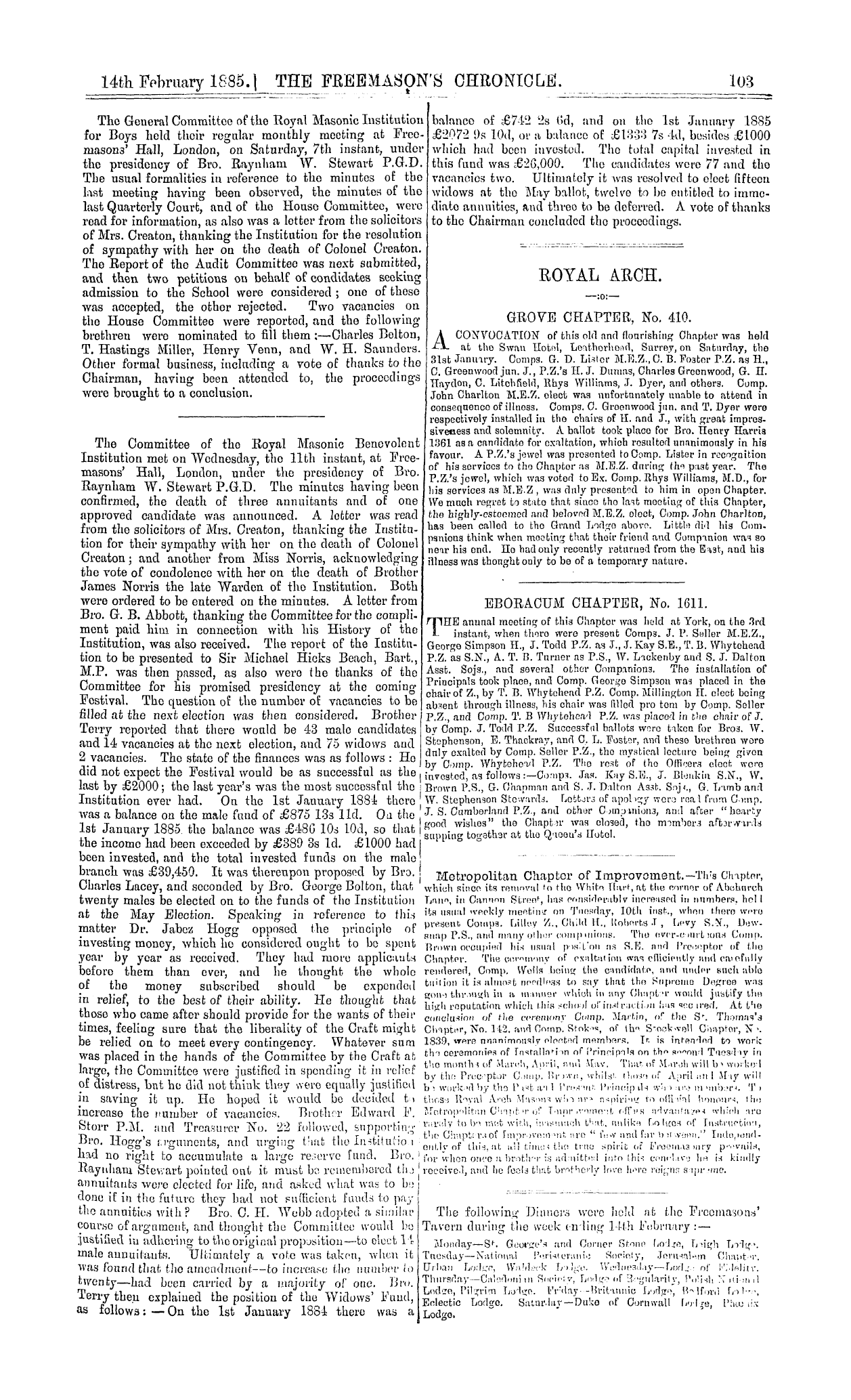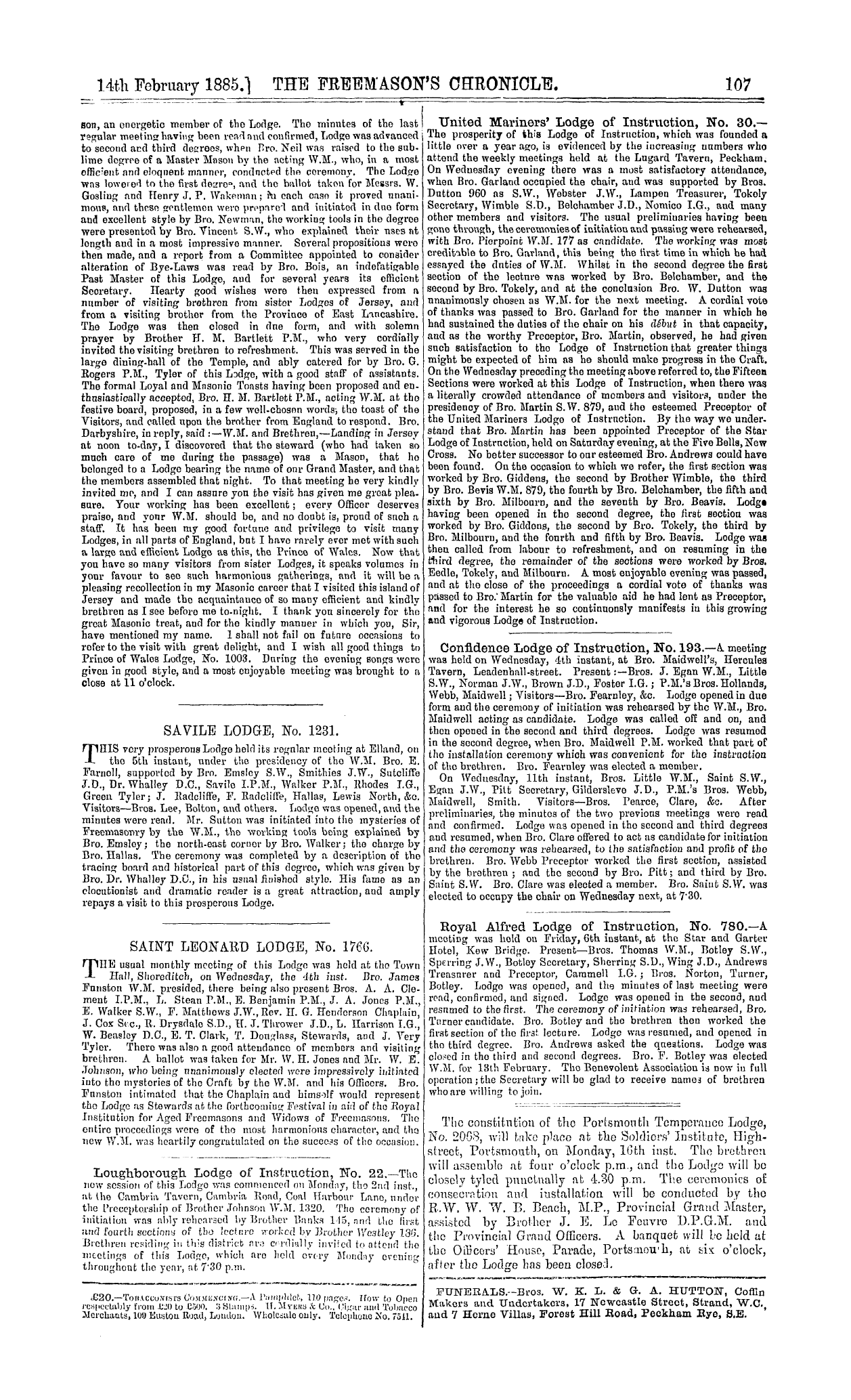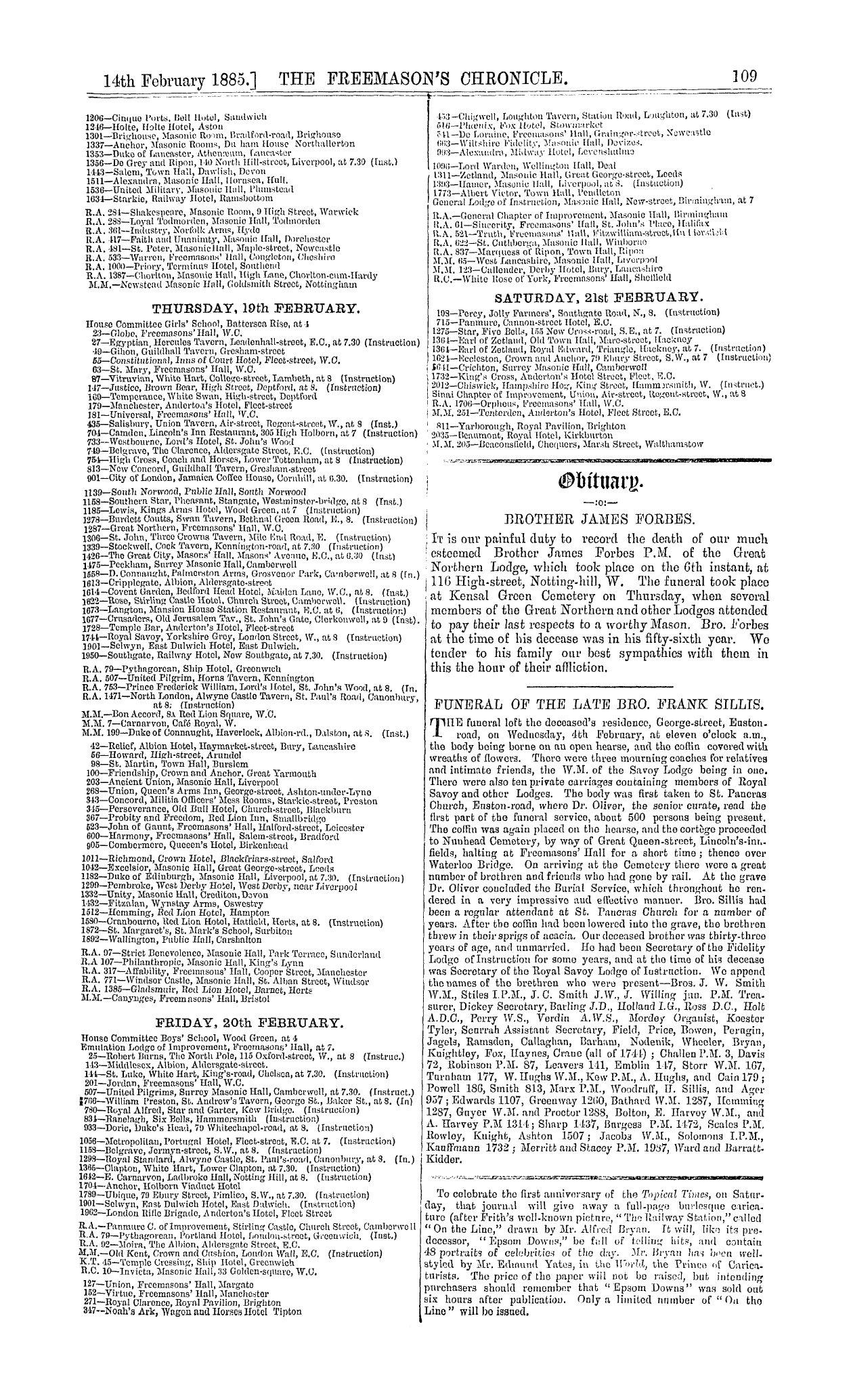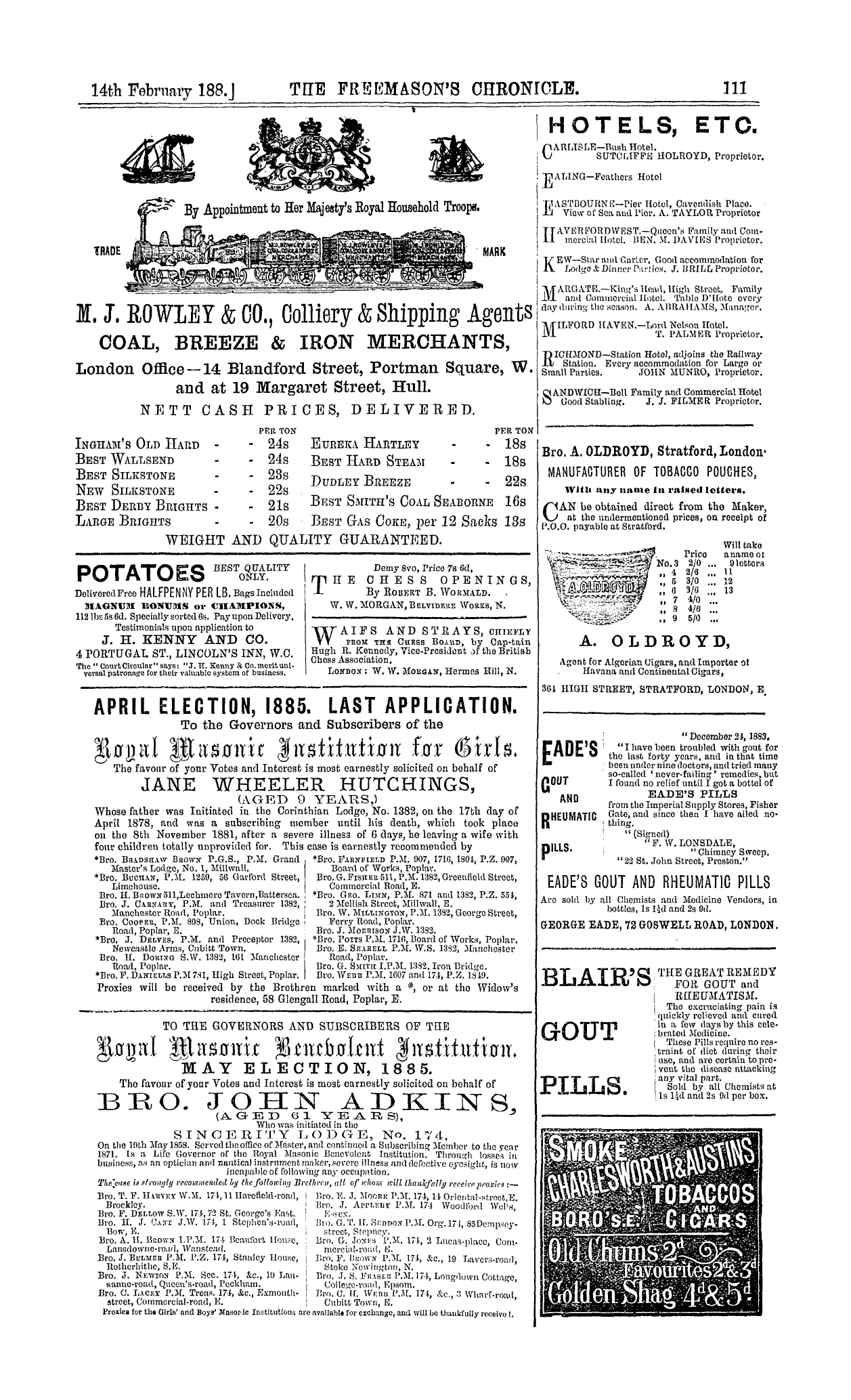-
Articles/Ads
Article RIGHT OF VISIT. ← Page 2 of 2 Article DEVELOPMENT OF THE ROYAL ARCH DEGREE. Page 1 of 2 Article DEVELOPMENT OF THE ROYAL ARCH DEGREE. Page 1 of 2 →
Note: This text has been automatically extracted via Optical Character Recognition (OCR) software.
Right Of Visit.
Masons , or pass them , as was common m former times , there could bo no visitors at all ; and when Master Masons were raised , whether in such a Lodge or in a Grand Lodge , the case must have been tho same ; and so also when the
Grand Master made Masons at sight . But because Lodges are now chartered to work at a particular place , and are for many purposes business corporations , and for such purposes have particular members , united under bye-laws ,
all other Masons who come to such a Lodge aro called visitors , which in truth they are , as to tho business character and affairs of such Lodge , and havo no right to vote there on any matter falling under tho bye-laws ; but
as to tho work , that is a matter which pertains to the universal Lodgo ; that is , to tho whole Craft ; hence all can see that their right to be present at any work is altogether paramount to any right of objection which a Lodge
member might claim . Tho visitor ' s right to see and assist at the work , in the way in which all present are required to assist , cannot be denied by the Worshipful Master , for he opens his Lodge from East to West , and between the
North and South , and not at all as a local institution ; and he does so standing in place of tho Grand Master , who is necessarily Master of every particular Lodge , and when present sits in the East with the Worshipful Master on his
right hand . This is why the Lodge receives the Grand Master with
the Grand Honours ; for that is the Masonic recognition that he is rightfully in the chair of Solomon , as the Oriental chair is called ; and no honours aro to be given to any other officer ; and if any are given to a proxy of the
Grand Master they are not intended for him , but for the authority of the Master who sent him . Least of all should Grand Honours be given to a Deputy Grand Master in his own right , for he is not a Masonic officer at all , but only an innovation . —Voice of Masonry .
Development Of The Royal Arch Degree.
DEVELOPMENT OF THE ROYAL ARCH DEGREE .
BY BRO . JACOB NORTON . ( Continued from p 67 . )
J TP to within a month 1 believed that the ritual transit lated in 1882 was the bona fide English Royal Arch Ritual of about 1812 . The translator , as well as a very eminent English Brother and 33 degreer , intimated that
somo portions of that Ritual were taken out of the A . and A rite ; but a recent find of another Royal Arch ritual con vinced me that those portions were not taken out of the A
and A . Rite , but that the Charleston manufacturers of tho A . and A . Rite copied those notions from this very ritual . It is a well-known fact that tho G . L . of England
chartered a Lodge held in Paris in 1724 . Of course , the ritual then consisted of only three degrees , and a very crude ritual it was . The English brethren since then made successive additions to their original ritual . Here , in America ,
Thos . Smith Webb made additions to the English ritual , and , as a matter of course , the French brethren also made successive additions to their ritual . The origin of Masonry was a mystery ; Anderson ' s history of Masonry did not
satisfy Chevalier Ramsay ( a Scotchman by birth , who was in the service of the Pretender , lived in Paris , and was one of the earliest Masons initiated in Paris ) . In 1735 the Lodge in Paris conferred the new title of " Masonic Orator " on
Ramsay , and in his oration he asserted that Masonry descended from the Crusaders . This notion took root , and Ramsay and others set to work in inventing a series of degrees with legends of all nations and ages . Some of
those legends and degrees were said to have been preserved in Scotland , hence they talk about " Scottish Rite . " Somewhere between 1745 and 1758 they had in Paris no less than twenty-five degrees , and they seem to have thought
that they had quite enough , and those degrees were styled the " Rite of Perfection . " The Royal Arch was evidently one of the earliest of their new degrees , and it seems to have been the seventh degree of the new Rite . In 17 G 2
Stephen Morin brought the Rites of Perfection to the West Indies , and from thence they were imported into Charleston , ^ S . C . The Charleston luminaries did not consider the " Rite of Perfection quite perfect , so they went to work and pretended to have received a charter from Frederick
the Great , rehashed the twenty-five degrees into thirtythree degrees , and in 1801 they proclaimed themselves
Development Of The Royal Arch Degree.
S . C . of the " Ancient and Accepted Rite , " or A . and A . Rite .
This " A . and A . Rite was conferred in Charleston upon Count Do Grasso , a refugee from Hayti ; he carried the new Rite to Paris . The French Orient , who had never heard that Frederick the Great was a high degreer , would
not listen to De Grasse , and treated his pretensions with contempt . Tho Count thereupon set up a concern of his own , and began to manufacture thirty-thirds . At last , for tho sake of peace , the French Orient yielded , and from Perfection Riters thoy became A . and A . Riters .
Marconnay , who transcribed tho Royal Arch Ritual which was brought to New York from Hayti in 1833 , knowing it was not one of tho A . and A . degrees , it being headed the " seventh degree , " & c , and as the
Royal Arch is called hero the seventh degree of the York Rite , " he headed the ritual accordingly , and added that it was sent from England to Port au Prince , in Hayti , in 1802 . and as there was no evidence to contradict
Marconnay ' s statement , we all took it for granted that it was an old English R . A . ritual . Bro . Albert Pike , however , also found a ritual of the R . A . in New Orleans , which is headod " tho seventh degree
of the Ancient Rite . " This ritual was also brought from Hayti ( somewhere between 1797 and 1809 ) . Bro . Pike furnishes conclusive evidence that the said ritual was used in a R . A . Chapter chartered by the Grand Orient of
France ( between 1784 and 1796 ) for Port-au-Princo , in Hayti , and on carefully comparing the ritual translated by De la Grania with that of Pike , I found them both alike .
Paragraph after paragraph begin and end alike . This fact left no doubt on my mind that the ritual in question was not an English R . A . ritual , but it was unquestionably tho parent of the English R . A . degree . The Charlestonian
A . and A . Riters , however , seem to have rehashed the legend of the old seventh degree , and developed it in
the thirteenth and fourteenth , & o . degrees of the A . and A . Rite into the following cock and bull story : " Enoch , the son of Jared . . the sixth in descent
from Adam . . In a vision the Deity appeared to him . . and said to him , ' Enoch , tbou hast longed to know my true name ; arise , and follow me and thou shalt know it . '
" Enoch , accepting his vision as an inspiration , journeyed in search of the mountain he had seen in his dream , until weary of the search ; he stopped in the land of Canaan , then already populous with the descendants of Adam , and
there employed workmen ; and with the help of his own son , Methuselah , he excavated nine apartments one above another , and each roofed with an arch , as he had seen in his dream , the lowest being hewn out of the solid
rock . In the crown of each arch he left a narrow aperture , closed with a square stone , and over the upper one he built a modest temple , roofless , and of huge unhewn
stones , to the Grand Architect of the Universe . Upon a triangular plate of gold , inlaid with many precious gems , he engraved the ineffable name of God , and sank a plate into one face of a cube of agate .
" None knew of the deposit of the precious treasure ; and that it might remain undiscovered , and survive the Flood , which it was known to Enoch would soon overwhelm the
world in one vast sea of mire , he covered the aperture , and the stone that closed it and the great ring of iron used to raise the stone , with the granite pavement of his primitive temple .
" Then fearing that all knowledge of the arts and sciences would be lost in the universal flood he built two great columns upon a high hill—one of brass to resist the water ,
and one of granite to resist fire . On the granite column was written in hieroglyphics a description of the subterranean apartments ; on the one of brass , the rudiments of the arts and sciences .
" The granite column was overturned and swept away and worn to a shapeless mass by the Deluge , but that of brass stood firm and was found by Noah . Thenceforward the true name of God remained unknown until He said
unto Moses in Egypt , when He ordered him to go to Pharaoh , and cause him to send forth the children of Israel out of Egypt , ' I am that which I was and shall be , I am the God of thy fathers , the God of Abraham , of
Isaac , and of Jacob . Thus shalt thou say unto the children of Israel , HE WHO IS hath sent me unto you , I am the Lord that appeared to Abraham , to Isaac , and to Jacob , by My name , AL SHEDI ; but M y name—I did not show them . '
Note: This text has been automatically extracted via Optical Character Recognition (OCR) software.
Right Of Visit.
Masons , or pass them , as was common m former times , there could bo no visitors at all ; and when Master Masons were raised , whether in such a Lodge or in a Grand Lodge , the case must have been tho same ; and so also when the
Grand Master made Masons at sight . But because Lodges are now chartered to work at a particular place , and are for many purposes business corporations , and for such purposes have particular members , united under bye-laws ,
all other Masons who come to such a Lodge aro called visitors , which in truth they are , as to tho business character and affairs of such Lodge , and havo no right to vote there on any matter falling under tho bye-laws ; but
as to tho work , that is a matter which pertains to the universal Lodgo ; that is , to tho whole Craft ; hence all can see that their right to be present at any work is altogether paramount to any right of objection which a Lodge
member might claim . Tho visitor ' s right to see and assist at the work , in the way in which all present are required to assist , cannot be denied by the Worshipful Master , for he opens his Lodge from East to West , and between the
North and South , and not at all as a local institution ; and he does so standing in place of tho Grand Master , who is necessarily Master of every particular Lodge , and when present sits in the East with the Worshipful Master on his
right hand . This is why the Lodge receives the Grand Master with
the Grand Honours ; for that is the Masonic recognition that he is rightfully in the chair of Solomon , as the Oriental chair is called ; and no honours aro to be given to any other officer ; and if any are given to a proxy of the
Grand Master they are not intended for him , but for the authority of the Master who sent him . Least of all should Grand Honours be given to a Deputy Grand Master in his own right , for he is not a Masonic officer at all , but only an innovation . —Voice of Masonry .
Development Of The Royal Arch Degree.
DEVELOPMENT OF THE ROYAL ARCH DEGREE .
BY BRO . JACOB NORTON . ( Continued from p 67 . )
J TP to within a month 1 believed that the ritual transit lated in 1882 was the bona fide English Royal Arch Ritual of about 1812 . The translator , as well as a very eminent English Brother and 33 degreer , intimated that
somo portions of that Ritual were taken out of the A . and A rite ; but a recent find of another Royal Arch ritual con vinced me that those portions were not taken out of the A
and A . Rite , but that the Charleston manufacturers of tho A . and A . Rite copied those notions from this very ritual . It is a well-known fact that tho G . L . of England
chartered a Lodge held in Paris in 1724 . Of course , the ritual then consisted of only three degrees , and a very crude ritual it was . The English brethren since then made successive additions to their original ritual . Here , in America ,
Thos . Smith Webb made additions to the English ritual , and , as a matter of course , the French brethren also made successive additions to their ritual . The origin of Masonry was a mystery ; Anderson ' s history of Masonry did not
satisfy Chevalier Ramsay ( a Scotchman by birth , who was in the service of the Pretender , lived in Paris , and was one of the earliest Masons initiated in Paris ) . In 1735 the Lodge in Paris conferred the new title of " Masonic Orator " on
Ramsay , and in his oration he asserted that Masonry descended from the Crusaders . This notion took root , and Ramsay and others set to work in inventing a series of degrees with legends of all nations and ages . Some of
those legends and degrees were said to have been preserved in Scotland , hence they talk about " Scottish Rite . " Somewhere between 1745 and 1758 they had in Paris no less than twenty-five degrees , and they seem to have thought
that they had quite enough , and those degrees were styled the " Rite of Perfection . " The Royal Arch was evidently one of the earliest of their new degrees , and it seems to have been the seventh degree of the new Rite . In 17 G 2
Stephen Morin brought the Rites of Perfection to the West Indies , and from thence they were imported into Charleston , ^ S . C . The Charleston luminaries did not consider the " Rite of Perfection quite perfect , so they went to work and pretended to have received a charter from Frederick
the Great , rehashed the twenty-five degrees into thirtythree degrees , and in 1801 they proclaimed themselves
Development Of The Royal Arch Degree.
S . C . of the " Ancient and Accepted Rite , " or A . and A . Rite .
This " A . and A . Rite was conferred in Charleston upon Count Do Grasso , a refugee from Hayti ; he carried the new Rite to Paris . The French Orient , who had never heard that Frederick the Great was a high degreer , would
not listen to De Grasse , and treated his pretensions with contempt . Tho Count thereupon set up a concern of his own , and began to manufacture thirty-thirds . At last , for tho sake of peace , the French Orient yielded , and from Perfection Riters thoy became A . and A . Riters .
Marconnay , who transcribed tho Royal Arch Ritual which was brought to New York from Hayti in 1833 , knowing it was not one of tho A . and A . degrees , it being headed the " seventh degree , " & c , and as the
Royal Arch is called hero the seventh degree of the York Rite , " he headed the ritual accordingly , and added that it was sent from England to Port au Prince , in Hayti , in 1802 . and as there was no evidence to contradict
Marconnay ' s statement , we all took it for granted that it was an old English R . A . ritual . Bro . Albert Pike , however , also found a ritual of the R . A . in New Orleans , which is headod " tho seventh degree
of the Ancient Rite . " This ritual was also brought from Hayti ( somewhere between 1797 and 1809 ) . Bro . Pike furnishes conclusive evidence that the said ritual was used in a R . A . Chapter chartered by the Grand Orient of
France ( between 1784 and 1796 ) for Port-au-Princo , in Hayti , and on carefully comparing the ritual translated by De la Grania with that of Pike , I found them both alike .
Paragraph after paragraph begin and end alike . This fact left no doubt on my mind that the ritual in question was not an English R . A . ritual , but it was unquestionably tho parent of the English R . A . degree . The Charlestonian
A . and A . Riters , however , seem to have rehashed the legend of the old seventh degree , and developed it in
the thirteenth and fourteenth , & o . degrees of the A . and A . Rite into the following cock and bull story : " Enoch , the son of Jared . . the sixth in descent
from Adam . . In a vision the Deity appeared to him . . and said to him , ' Enoch , tbou hast longed to know my true name ; arise , and follow me and thou shalt know it . '
" Enoch , accepting his vision as an inspiration , journeyed in search of the mountain he had seen in his dream , until weary of the search ; he stopped in the land of Canaan , then already populous with the descendants of Adam , and
there employed workmen ; and with the help of his own son , Methuselah , he excavated nine apartments one above another , and each roofed with an arch , as he had seen in his dream , the lowest being hewn out of the solid
rock . In the crown of each arch he left a narrow aperture , closed with a square stone , and over the upper one he built a modest temple , roofless , and of huge unhewn
stones , to the Grand Architect of the Universe . Upon a triangular plate of gold , inlaid with many precious gems , he engraved the ineffable name of God , and sank a plate into one face of a cube of agate .
" None knew of the deposit of the precious treasure ; and that it might remain undiscovered , and survive the Flood , which it was known to Enoch would soon overwhelm the
world in one vast sea of mire , he covered the aperture , and the stone that closed it and the great ring of iron used to raise the stone , with the granite pavement of his primitive temple .
" Then fearing that all knowledge of the arts and sciences would be lost in the universal flood he built two great columns upon a high hill—one of brass to resist the water ,
and one of granite to resist fire . On the granite column was written in hieroglyphics a description of the subterranean apartments ; on the one of brass , the rudiments of the arts and sciences .
" The granite column was overturned and swept away and worn to a shapeless mass by the Deluge , but that of brass stood firm and was found by Noah . Thenceforward the true name of God remained unknown until He said
unto Moses in Egypt , when He ordered him to go to Pharaoh , and cause him to send forth the children of Israel out of Egypt , ' I am that which I was and shall be , I am the God of thy fathers , the God of Abraham , of
Isaac , and of Jacob . Thus shalt thou say unto the children of Israel , HE WHO IS hath sent me unto you , I am the Lord that appeared to Abraham , to Isaac , and to Jacob , by My name , AL SHEDI ; but M y name—I did not show them . '















